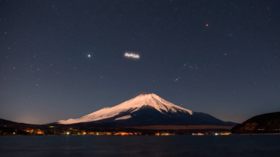Goodbye darkness, my old friend: Russian startup wants to place luminous ads in low-Earth orbit

In a move straight out of a dystopian blockbuster, a Russian startup wants to put giant luminous billboards into orbit to bombard a “potential audience of 7 billion people” with advertising from space.
StartRocket aims to use a formation of tiny cube satellites to create programmable displays in the night sky in a low-Earth orbit of 400-500 kilometers (248-310 miles). Each satellite would have a single collapsible sail to reflect the light of the sun, forming a single pixel in the giant nocturnal display measuring 50 square kilometers across (19 square miles).
The company claims it has overcome the technical issues surrounding flying a formation of micro satellites around Earth and plans to launch its Orbital Display by 2020, displaying ads by 2021. The reason for the 12-month gap is unclear, as is the cost of displaying an ad in orbit.
“We are ruled by brands and events,” project leader Vlad Sitnikov told Futurism.
“We will live in space, and humankind will start delivering its culture to space. The more professional and experienced pioneers will make it better for everyone.”
Also on rt.com China becomes 1st nation to grow biological life on the MoonThe Orbital Display would be programmed to display corporate logos for slots of six minutes between three and four times a day. However, the display has yet to be tested, funded or approved in a process which is likely to prove next to impossible given the sheer volume of red tape, rules, regulations and standards when it comes to international advertising.
“Is it technologically possible? Yes,” Randy Segal, an attorney who specializes in space and satellite law at the firm Hogan Lovells, told Futurism. “Is it something that regulators will permit? Questionable.”
Astronomers, professional and amateur alike, already disgruntled at worldwide light pollution have already recoiled in horror at the mere suggestion that celestial real estate be handed over to advertisers.
“It's a threat to the ability to do astronomical research from the ground,” astronomer John Barentine of the International Dark Sky Association told Astronomy.com. “Every one of those moving blips of light in the night sky is something that can interfere with our ability to collect photons from astronomical sources.”
For no reason at all, here's what it looks like when a satellite goes through Hubble's field of view whilst you are trying to image something in the distant solar system. pic.twitter.com/eLWR1ncdqx
— Alex Parker (@Alex_Parker) January 25, 2018
There’s some good news for scientists, however: at the chosen altitude the display's orbit would decay to such a degree that it would burn up in the atmosphere in roughly a year.
Comments below the company’s own promotional video seem to capture a small subsection of public opinion.
“NO NO NO NO NO. Blow them out of the sky,” writes Steve Lafreniere.
James Lowenthal agreed, saying: “What a truly horrible idea. May it never, ever come to fruition. I will boycott any company that advertises this way.”
While not unprecedented, given that a Japanese start up is planning on creating artificial meteor showers in the near future, and China is proposing floating an artificial moon into orbit, it remains to be seen whether StartRocket’s boorish billboards ever get off the ground.
Also on rt.com China is launching a fake, extra-bright moon to cut the cost of city lightsLike this story? Share it with a friend!














